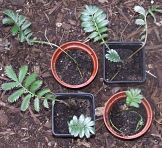
 |
Courtesy of (left to right) OakleyOriginals, hardworkinghippy, fishermansdaughter  Keeping down the weeds: hoeing potatoes, mulching potatoes, buckwheat ground-cover around Jerusalem artichokes |
.jpg) |
| Creeping Jenny keeping down the weeds around sea kale |
 |
| Wild strawberries around a tree onion |
.jpg) |
| Siberian purslane is evergreen, perennial and edible |
 |
| Silverweed (Argentina anserina) |
 |
| Lawn chamomile (Chamaemelum nobile 'Treneague') |